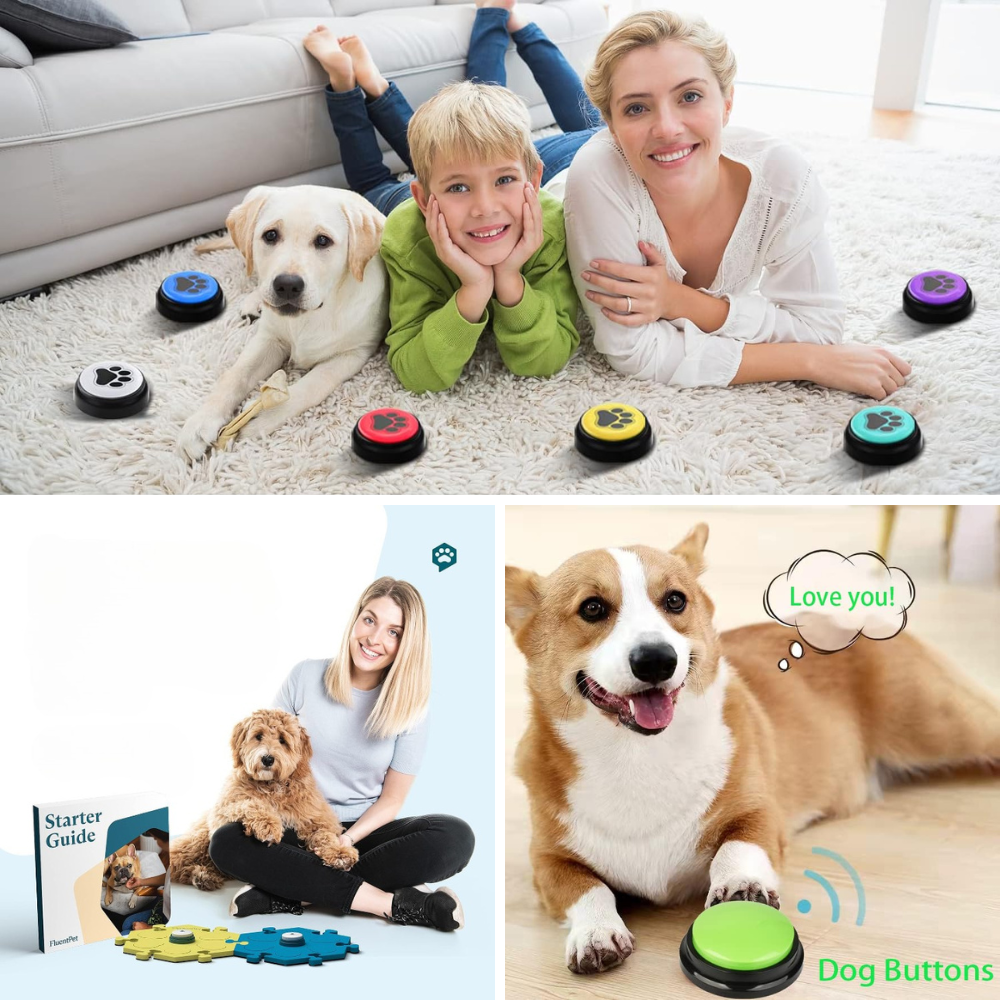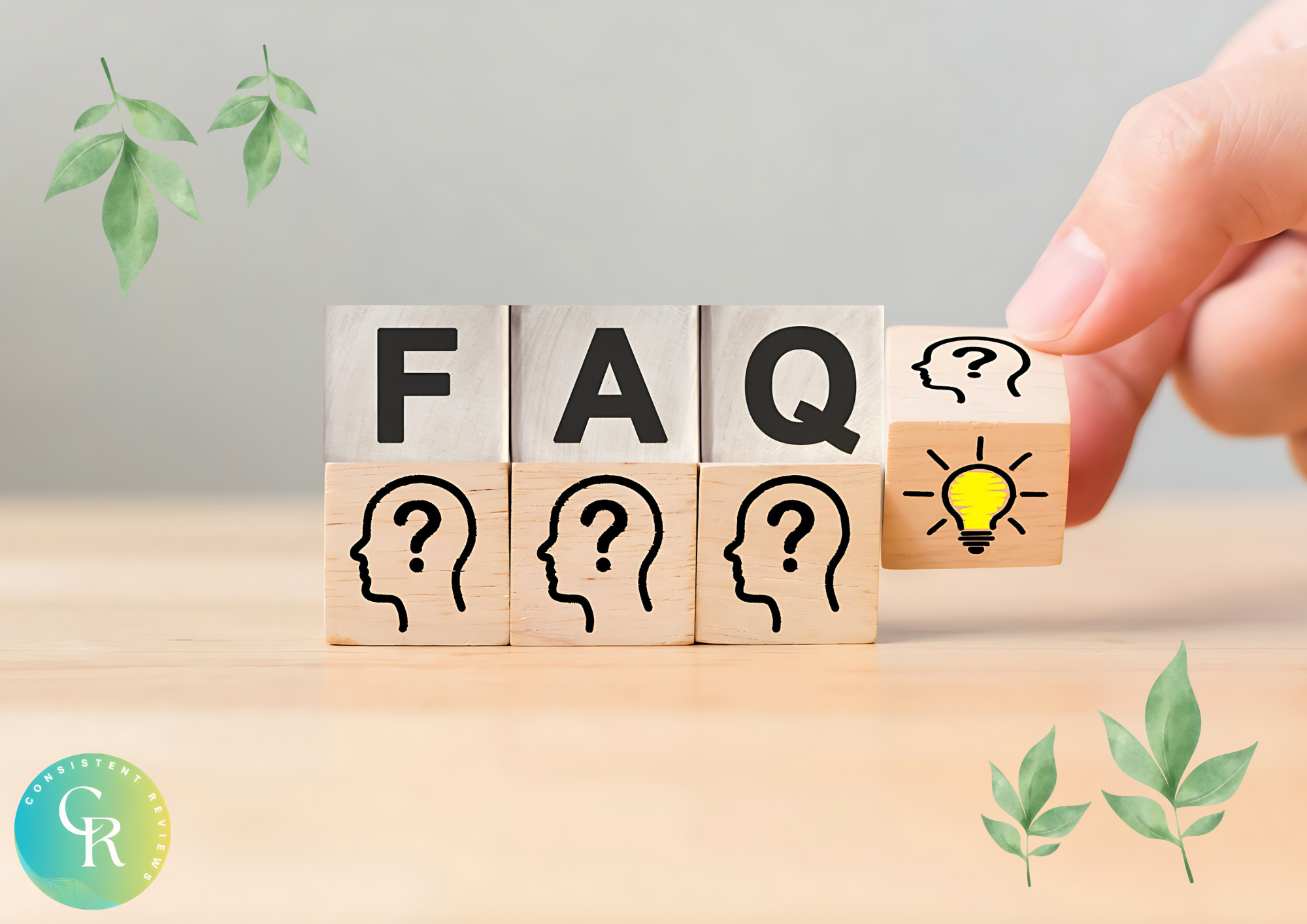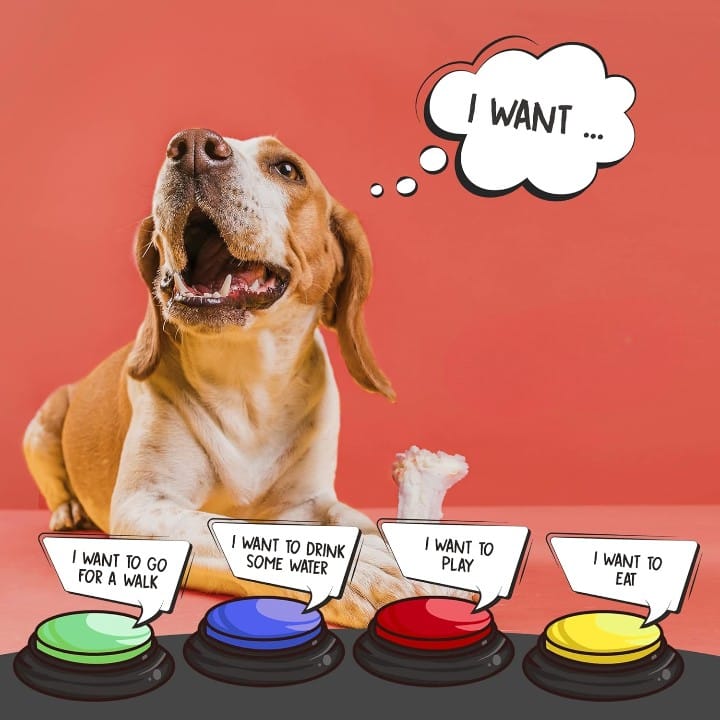Key Takeaways:
- Dog talking buttons can enable dogs to communicate specific needs or thoughts by pressing buttons that emit pre-recorded words.
- Training and consistency are crucial for dogs to effectively use talking buttons, with positive reinforcement playing a key role.
- Research is ongoing, but anecdotal evidence suggests that some dogs can learn to use these devices to communicate with their owners.
Dogs have always found ways to communicate with their human companions, from barking and body language to more subtle signs. But what if they could use words to express their needs and thoughts? This is the idea behind dog talking buttons, a concept that has gained popularity among pet parents who are eager to bridge the communication gap with their furry friends. But do these devices work? Let's delve into the world of canine communication and technology to find out.
Understanding Dog-Talking Buttons
The concept of dog-talking buttons isn't entirely new. Speech-language pathologists have used similar devices to aid human communication for years. The idea is simple: dogs learn to press buttons that correspond to words, allowing them to 'speak' their minds.
The most famous example is perhaps a dog named Stella, whose owner, a speech-language pathologist, trained her to use such a device. Videos of Stella pressing buttons to form sentences like "Want outside" have captivated dog owners worldwide.
Training Dogs to Use Buttons
Training a dog to use talking buttons involves the same process as teaching any new skill: patience, consistency, and positive reinforcement training. The first step is usually to associate the pressing of a button with a specific action or need, such as "food" or "walk." Over time, with enough repetition and rewards, many dogs can learn to press the button when they want what the button represents. This operant conditioning is a fundamental principle of animal and veterinary science.
The Role of Positive Reinforcement
Positive reinforcement is key when training dogs to use talking buttons. By rewarding the dog each time they press the correct button, they learn that this action has a desirable outcome. This encourages them to repeat the behavior.
For example, if a dog learns that pressing the 'food' button results in them getting a meal, they are more likely to use it when they're hungry. This method of training is widely supported by experts in veterinary medicine and comparative cognition labs.
The Science Behind the Buttons
Have you ever wondered if there's a science to how dogs can 'talk' using buttons? Well, let's dive into the fascinating world of canine communication. Researchers like Christina Hunger, a speech-language pathologist, have been at the forefront of this exploration. Hunger's dog, Stella, has become somewhat of a celebrity in the Dog Buttons community. By pressing buttons associated with words, Stella can seemingly express her desires and feelings. This isn't just a party trick; it's a glimpse into how dogs communicate and understand our world.
The science hinges on the dog's ability to associate a specific button with a particular outcome or need. For instance, a button may be labeled "outside" and placed near the door. With consistent training, dogs learn to press this button when they want to go out. It's a form of operant conditioning, a concept well-known in animal training.
Dr. Susan Hazel from the University of Adelaide suggests that dogs are adept at reading their owner's body language, which may aid them in using the buttons appropriately. This intersection of behaviorism and cognitive science offers a myriad of ways for us to understand our furry friends better.
Integrating Buttons into Daily Life
Integrating dog talking buttons into your daily routine can be a rewarding experience for both you and your pet. Imagine your dog pressing a button labeled "play" when they want to engage in some fun activities, or "food" when they're hungry. It's not just about the words; it's about the bond that forms when your dog realizes they have a voice. This process requires patience and consistency, but the rewards are immense. You'll need to train dogs to use the buttons in various contexts, gradually expanding their vocabulary and understanding.
When you bring in a new pet sitter or change your dog's environment, the buttons can serve as a bridge of communication. The sitter can quickly learn what your dog needs by observing which buttons they press. This can be especially helpful for dogs that are shy or have anxiety issues. Florida Institute of Technology has been involved in data collection started by owners who use dog buttons, aiming to understand the efficacy and impact of these devices.
As we continue to explore the capabilities of our canine companions, the buttons may become an essential tool in the way we interact with and care for our animals, be they dogs or even cats.
Research and Evidence
Research into the efficacy of dog-talking buttons is still in its early stages. The Comparative Cognition Lab at UC San Diego has started data collection to study how dogs use these devices. Anecdotal reporting coming from pet parents who have tried the buttons with their own dogs suggests that some dogs can indeed learn to use them effectively.
However, other factors, such as the individual dog's interest and aptitude, play a significant role.
Case Studies and Success Stories
There are numerous stories of dogs who have successfully learned to use talking buttons. Bunny, a Sheepadoodle owned by Alexis Devine, has become an internet sensation for her use of the buttons.
Bunny has been trained to use dozens of buttons for various words and has even been observed asking questions, indicating a level of understanding that goes beyond simple button presses.
The Fun and Bonding Aspect
Even if the scientific jury is still out on whether dog-talking buttons truly work, there's no denying the fun and bonding experience they can provide. Spending time training your dog is always a valuable way to strengthen your relationship, and the process of teaching them to use the buttons can be a rewarding activity for both the pet and the owner.
Buying Talking Buttons for Your Dog
If you're interested in buying talking buttons for your dog, there are a few things to keep in mind. First, start with fewer than a dozen buttons to avoid overwhelming your pup.
Choose words that are relevant to your dog's life, like "play," "food," or "outside." Remember, consistency is key, so use the buttons regularly and incorporate them into your daily routine.


do dog-talking buttons work?
While the effectiveness of dog-talking buttons is still up for debate, many owners have reported success with using them to communicate with their pets. Some studies have also shown promising results in teaching dogs how to use the buttons to indicate their needs or desires.
How long does it take for a dog to learn to use talking buttons?
The time it takes for a dog to learn to use talking buttons varies greatly depending on the dog's learning speed, the consistency of training, and the number of buttons being used. Some dogs may pick up the concept in a few weeks, while others may take several months.
Are talking buttons suitable for all dogs?
While many dogs can learn to use talking buttons, they may not be suitable for all dogs. Factors such as breed, age, temperament, and the owner's commitment to training can all influence a dog's ability to use these devices.
Can Dogs Understand Human Language?
The question of whether dogs can understand human language is a complex one. While dogs can learn to associate words with actions or objects, it's a leap to say they understand language in the same way humans do. Dogs are very adept at reading their owner's body language and can pick up on cues that might make it seem like they understand more than they do. However, the ability to string multiple buttons together to form a sentence suggests a higher level of cognitive processing.

Dog talking buttons are an intriguing tool that may offer a glimpse into our pets' minds. While the evidence is still anecdotal, many dog owners report success with these devices. Training your dog to use talking buttons requires patience, consistency, and positive reinforcement. Whether or not dogs truly understand human language, the use of these buttons can enhance the bond between dogs and their owners and provide a fun way to interact with our canine companions.










